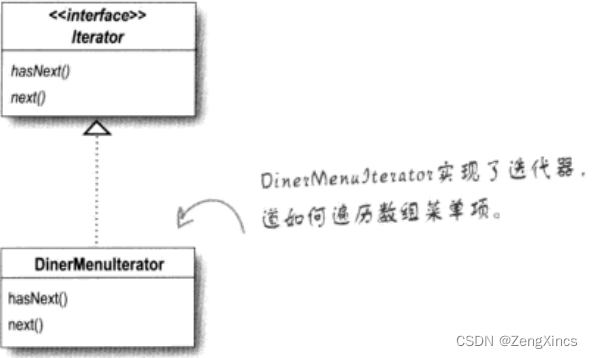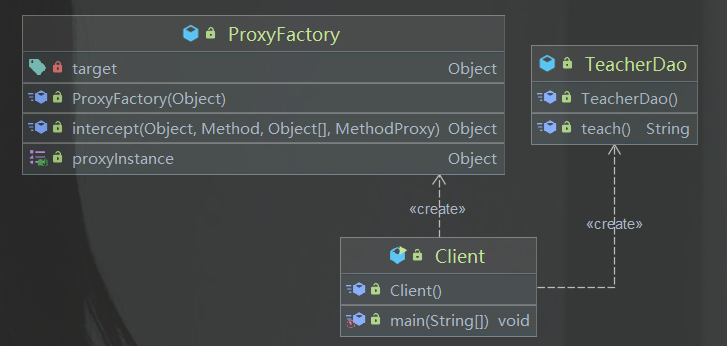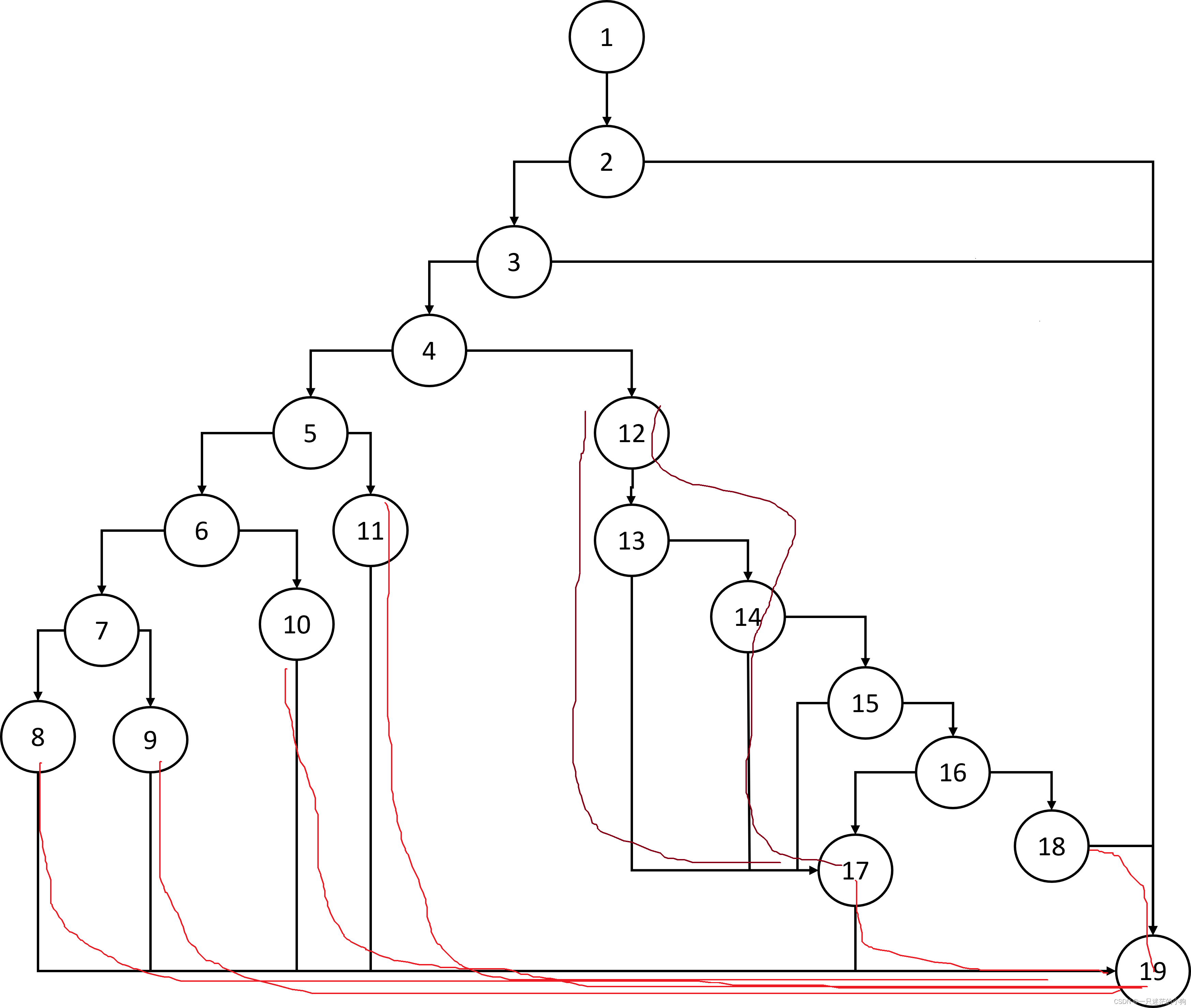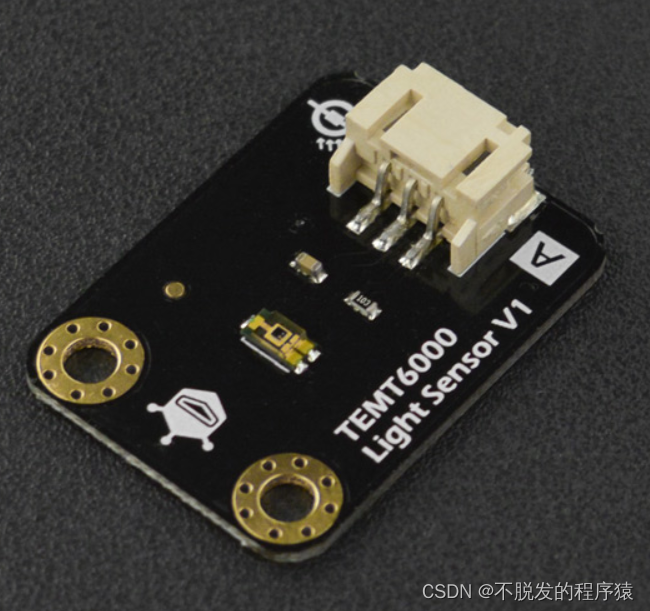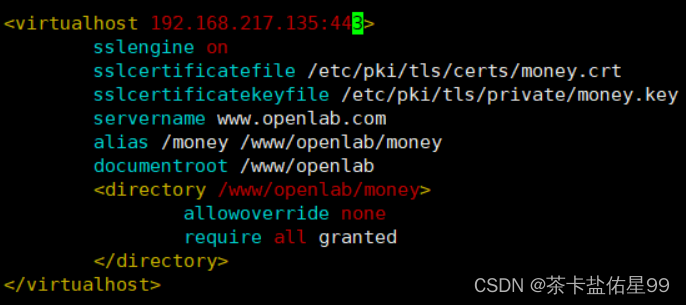题目、解析和代码
题目:给定一个单链表,判断其中是否有环的存在
解析:这里使用两个遍历速度不一样的结点进行判断,一个慢结点从首结点开始遍历,这个结点每次只遍历一个结点;一个快结点从第二个结点进行遍历,一次遍历两个结点。
若是链表中存在环,那么必然在某个结点处相遇;若是没有环,那么尾结点后继指针指向空。
LinkedListChainTest.c代码如下:
#include <stdio.h>
#include <stdlib.h>
#include <stdbool.h>
typedef struct operatorNodeStruce {
int data;
struct operatorNodeStruce* next;
}operatorNode;
int main(int argc, char *argv[]) {
if(argc == 1){
printf("请输入链表中结点个数和环的接连位置\n");
return 0;
}else if(argc == 2){
printf("请输入环的接连位置,负数表示没有环\n");
return 0;
}else if(argc > 3){
printf("参数不能大于3个\n");
return 0;
}
int nodeNumber = atoi(argv[1]);
int chainNodeIndex = atoi(argv[2]);
if(chainNodeIndex>nodeNumber){
printf("环的接连位置应该小于链表中结点个数\n");
return 0;
}
operatorNode *head = NULL;
operatorNode *storeNode = NULL;
int i=1;
// 创建链表,这个链表有nodeNumber个结点
for(;i<=nodeNumber;i++){
operatorNode *newNode = (operatorNode *)malloc(sizeof(operatorNode));
newNode->next = NULL;
newNode->data = i;
if(head == NULL){
head = newNode;
storeNode = head;
}else{
storeNode->next = newNode;
}
if(storeNode -> next != NULL){
storeNode = storeNode -> next;
}
}
//把最后一个结点的后继指针next指向第chainNodeIndex个结点,这样的话才能形成环
operatorNode *chainNodeBefore = NULL;
operatorNode *node= NULL;
if(chainNodeIndex > 0){
for(int i=0;i<chainNodeIndex;i++){
if(node == NULL){
node = head;
}
chainNodeBefore = node;
node = node->next;
}
}
storeNode->next = chainNodeBefore;
// 使用快慢结点法来判断是否有环,slowNode从第一个结点开始往后遍历,每次只遍历一个结点;fastNode从第二个结点开始往后遍历,每次遍历二个结点;
// 要是有环,快结点(fastNode)一定能够在某个结点处跟慢结点(slowNode)相遇
operatorNode *fastNode = NULL;
if(head->next != NULL){
fastNode = head->next;
}
operatorNode *slowNode = head;
while(true){
if(fastNode== NULL){
printf("无环\n");
return 0;
}else if(fastNode->next == NULL){
printf("无环\n");
return 0;
}else if(fastNode->next->next == NULL){
printf("无环\n");
return 0;
}else{
if(slowNode == fastNode){
printf("有环\n");
return 0;
}
slowNode = slowNode->next;
fastNode = fastNode->next->next;
}
}
return 0;
}
gcc LinkedListChainTest.c -o LinkedListChainTest进行编译。

./LinkedListChainTest 6 4表示这个链表有6个结点,最后一个结点后继指针指向第4个结点,就像下图所示。

./LinkedListChainTest 7 2表示这个链表有7个结点,最后一个结点后继指针指向第2个结点,就像下图所示。

./LinkedListChainTest 8 3表示这个链表有8个结点,最后一个结点后继指针指向第3个结点,就像下图所示。

遍历解析
以./LinkedListChainTest 6 4为例进行解析。

如上图,蓝色圆心虚线箭头为慢结点(slowNode)所在位置的标识。

如上图,绿色实心箭头为快结点(fastNode)所在位置的标识。
刚开始的实例图如下:
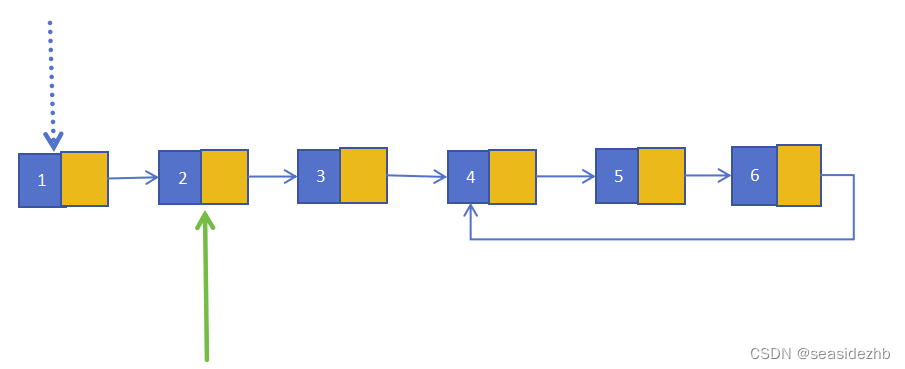
第1次遍历之后,慢结点在第2个结点处,快结点在第4个结点处:
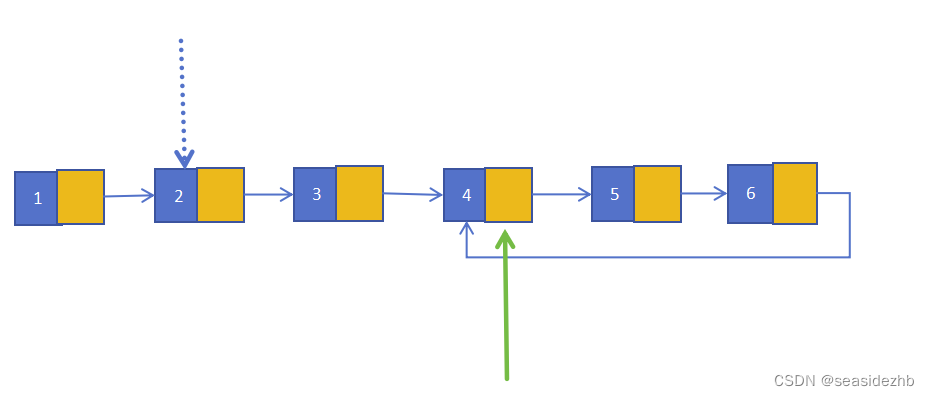
第2次遍历之后,慢结点在第3个结点处,快结点在第6个结点处:
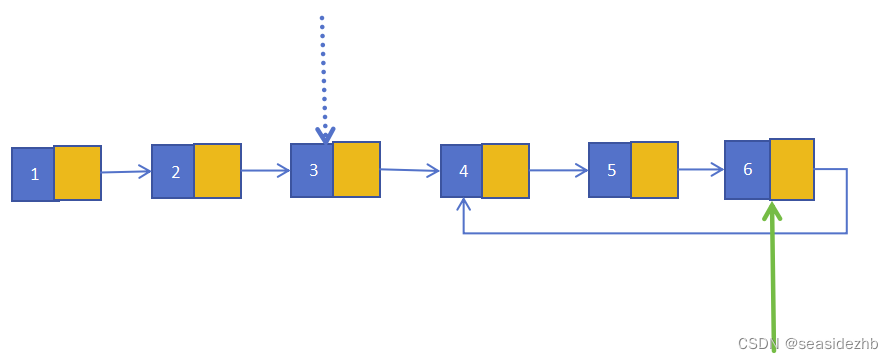
第3次遍历之后,慢结点在第4个结点处,快结点在第5个结点处:
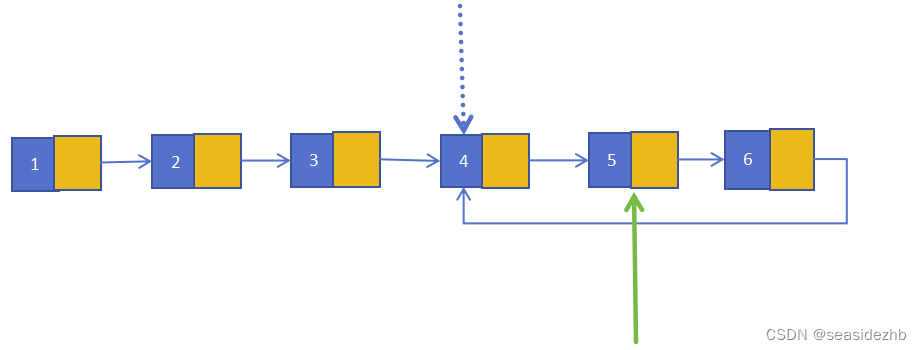
第4次遍历之后,慢结点在第5个结点处,快结点在第5个结点处,可以判定有环:

复杂度分析
| 结点个数 | 环的接连位置 | 快结点在环中所落位置 | 遍历次数 |
|---|---|---|---|
| 6 | 1 | 2、4、6 | 5 |
| 6 | 2 | 3、5、2、4、6 | 4 |
| 6 | 3 | 4、6 | 3 |
| 6 | 4 | 5、4、6 | 5 |
| 6 | 5 | 6 | 5 |
| 6 | 6 | 6 | 5 |
| 7 | 1 | 1、3、5、7、2、4、6 | 6 |
| 7 | 2 | 2、4、6 | 5 |
| 7 | 3 | 3、5、7、4、6 | 4 |
| 7 | 4 | 4、6 | 3 |
| 7 | 5 | 5、7、6 | 5 |
| 7 | 6 | 6 | 5 |
| 7 | 7 | 6 | 6 |
若链表中有2n(n>=1,是正整数,2n为偶数)个结点:
那么若环的连接位置
x不大于n,那么遍历次数为2n-x;
若是环的连接位置x大于n,则最多遍历次数小于等于2n-1,还没有总结出来公式。
若链表中有2n+1(n>=1,是正整数,2n+1为偶数)个结点:
那么环的连接位置
x若不大于n+1,那么遍历次数为2n+1-x;
若是环的连接位置x大于n,则最多遍历次数小于等于2n+1,还没有总结出来公式。
若是没有环的话,最多遍历次数是n/2。
综上所述,最好时间复杂度和最坏时间复杂度都是O(n),平均时间复杂度也是O(n)。
而空间复杂度是O(1),因为除了存储变量的必要空间,没有申请额外的空间。
因为需要更好地分析时间复杂度,所以,我把代码修改成下方所示:
#include <stdio.h>
#include <stdlib.h>
#include <stdbool.h>
typedef struct operatorNodeStruce {
int data;
struct operatorNodeStruce* next;
}operatorNode;
int main(int argc, char *argv[]) {
if(argc == 1){
printf("请输入链表中结点个数和环的接连位置\n");
return 0;
}else if(argc == 2){
printf("请输入环的接连位置,负数表示没有环\n");
return 0;
}else if(argc > 3){
printf("参数不能大于3个\n");
return 0;
}
int nodeNumber = atoi(argv[1]);
int chainNodeIndex = atoi(argv[2]);
if(chainNodeIndex>nodeNumber){
printf("环的接连位置应该小于链表中结点个数\n");
return 0;
}
operatorNode *head = NULL;
operatorNode *storeNode = NULL;
int i=1;
// 创建链表,这个链表有nodeNumber个结点
for(;i<=nodeNumber;i++){
operatorNode *newNode = (operatorNode *)malloc(sizeof(operatorNode));
newNode->next = NULL;
newNode->data = i;
if(head == NULL){
head = newNode;
storeNode = head;
}else{
storeNode->next = newNode;
}
if(storeNode -> next != NULL){
storeNode = storeNode -> next;
}
}
//把最后一个结点的后继指针next指向第chainNodeIndex个结点,这样的话才能形成环
operatorNode *chainNodeBefore = NULL;
operatorNode *node= NULL;
if(chainNodeIndex > 0){
for(int i=0;i<chainNodeIndex;i++){
if(node == NULL){
node = head;
}
chainNodeBefore = node;
node = node->next;
}
}
storeNode->next = chainNodeBefore;
// 使用快慢结点法来判断是否有环,slowNode从第一个结点开始往后遍历,每次只遍历一个结点;fastNode从第二个结点开始往后遍历,每次遍历二个结点;
// 要是有环,快结点(fastNode)一定能够在某个结点处跟慢结点(slowNode)相遇
operatorNode *fastNode = NULL;
if(head->next != NULL){
fastNode = head->next;
}
operatorNode *slowNode = head;
int chainNodetimes = 0;
while(true){
if(chainNodetimes != 0){
printf("fastNode data:%d\tslowNode data: %d\n",fastNode->data,slowNode->data);
}
if(fastNode== NULL){
printf("无环\n");
return 0;
}else if(fastNode->next == NULL){
printf("无环\n");
return 0;
}else if(fastNode->next->next == NULL){
printf("无环\n");
return 0;
}else{
if(slowNode == fastNode){
printf("循环次数:%d\n",chainNodetimes);
printf("有环\n");
return 0;
}
slowNode = slowNode->next;
fastNode = fastNode->next->next;
chainNodetimes++;
}
}
return 0;
}
